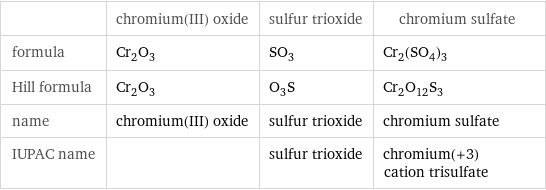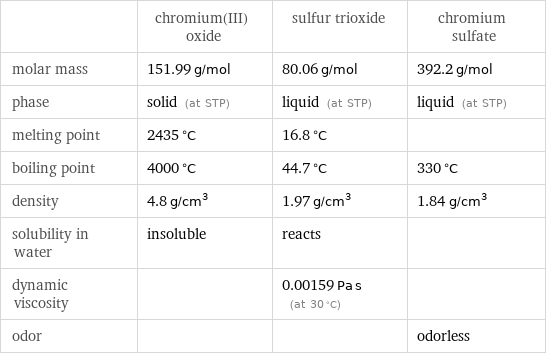Input interpretation

Cr_2O_3 chromium(III) oxide + SO_3 sulfur trioxide ⟶ Cr_2(SO_4)_3 chromium sulfate
Balanced equation

Balance the chemical equation algebraically: Cr_2O_3 + SO_3 ⟶ Cr_2(SO_4)_3 Add stoichiometric coefficients, c_i, to the reactants and products: c_1 Cr_2O_3 + c_2 SO_3 ⟶ c_3 Cr_2(SO_4)_3 Set the number of atoms in the reactants equal to the number of atoms in the products for Cr, O and S: Cr: | 2 c_1 = 2 c_3 O: | 3 c_1 + 3 c_2 = 12 c_3 S: | c_2 = 3 c_3 Since the coefficients are relative quantities and underdetermined, choose a coefficient to set arbitrarily. To keep the coefficients small, the arbitrary value is ordinarily one. For instance, set c_1 = 1 and solve the system of equations for the remaining coefficients: c_1 = 1 c_2 = 3 c_3 = 1 Substitute the coefficients into the chemical reaction to obtain the balanced equation: Answer: | | Cr_2O_3 + 3 SO_3 ⟶ Cr_2(SO_4)_3
Structures

+ ⟶
Names

chromium(III) oxide + sulfur trioxide ⟶ chromium sulfate
Equilibrium constant
![Construct the equilibrium constant, K, expression for: Cr_2O_3 + SO_3 ⟶ Cr_2(SO_4)_3 Plan: • Balance the chemical equation. • Determine the stoichiometric numbers. • Assemble the activity expression for each chemical species. • Use the activity expressions to build the equilibrium constant expression. Write the balanced chemical equation: Cr_2O_3 + 3 SO_3 ⟶ Cr_2(SO_4)_3 Assign stoichiometric numbers, ν_i, using the stoichiometric coefficients, c_i, from the balanced chemical equation in the following manner: ν_i = -c_i for reactants and ν_i = c_i for products: chemical species | c_i | ν_i Cr_2O_3 | 1 | -1 SO_3 | 3 | -3 Cr_2(SO_4)_3 | 1 | 1 Assemble the activity expressions accounting for the state of matter and ν_i: chemical species | c_i | ν_i | activity expression Cr_2O_3 | 1 | -1 | ([Cr2O3])^(-1) SO_3 | 3 | -3 | ([SO3])^(-3) Cr_2(SO_4)_3 | 1 | 1 | [Cr2(SO4)3] The equilibrium constant symbol in the concentration basis is: K_c Mulitply the activity expressions to arrive at the K_c expression: Answer: | | K_c = ([Cr2O3])^(-1) ([SO3])^(-3) [Cr2(SO4)3] = ([Cr2(SO4)3])/([Cr2O3] ([SO3])^3)](../image_source/7c4d0cd5841c8949d463253665dbe305.png)
Construct the equilibrium constant, K, expression for: Cr_2O_3 + SO_3 ⟶ Cr_2(SO_4)_3 Plan: • Balance the chemical equation. • Determine the stoichiometric numbers. • Assemble the activity expression for each chemical species. • Use the activity expressions to build the equilibrium constant expression. Write the balanced chemical equation: Cr_2O_3 + 3 SO_3 ⟶ Cr_2(SO_4)_3 Assign stoichiometric numbers, ν_i, using the stoichiometric coefficients, c_i, from the balanced chemical equation in the following manner: ν_i = -c_i for reactants and ν_i = c_i for products: chemical species | c_i | ν_i Cr_2O_3 | 1 | -1 SO_3 | 3 | -3 Cr_2(SO_4)_3 | 1 | 1 Assemble the activity expressions accounting for the state of matter and ν_i: chemical species | c_i | ν_i | activity expression Cr_2O_3 | 1 | -1 | ([Cr2O3])^(-1) SO_3 | 3 | -3 | ([SO3])^(-3) Cr_2(SO_4)_3 | 1 | 1 | [Cr2(SO4)3] The equilibrium constant symbol in the concentration basis is: K_c Mulitply the activity expressions to arrive at the K_c expression: Answer: | | K_c = ([Cr2O3])^(-1) ([SO3])^(-3) [Cr2(SO4)3] = ([Cr2(SO4)3])/([Cr2O3] ([SO3])^3)
Rate of reaction
![Construct the rate of reaction expression for: Cr_2O_3 + SO_3 ⟶ Cr_2(SO_4)_3 Plan: • Balance the chemical equation. • Determine the stoichiometric numbers. • Assemble the rate term for each chemical species. • Write the rate of reaction expression. Write the balanced chemical equation: Cr_2O_3 + 3 SO_3 ⟶ Cr_2(SO_4)_3 Assign stoichiometric numbers, ν_i, using the stoichiometric coefficients, c_i, from the balanced chemical equation in the following manner: ν_i = -c_i for reactants and ν_i = c_i for products: chemical species | c_i | ν_i Cr_2O_3 | 1 | -1 SO_3 | 3 | -3 Cr_2(SO_4)_3 | 1 | 1 The rate term for each chemical species, B_i, is 1/ν_i(Δ[B_i])/(Δt) where [B_i] is the amount concentration and t is time: chemical species | c_i | ν_i | rate term Cr_2O_3 | 1 | -1 | -(Δ[Cr2O3])/(Δt) SO_3 | 3 | -3 | -1/3 (Δ[SO3])/(Δt) Cr_2(SO_4)_3 | 1 | 1 | (Δ[Cr2(SO4)3])/(Δt) (for infinitesimal rate of change, replace Δ with d) Set the rate terms equal to each other to arrive at the rate expression: Answer: | | rate = -(Δ[Cr2O3])/(Δt) = -1/3 (Δ[SO3])/(Δt) = (Δ[Cr2(SO4)3])/(Δt) (assuming constant volume and no accumulation of intermediates or side products)](../image_source/998e825835084d2b0e428bb8f342e9e0.png)
Construct the rate of reaction expression for: Cr_2O_3 + SO_3 ⟶ Cr_2(SO_4)_3 Plan: • Balance the chemical equation. • Determine the stoichiometric numbers. • Assemble the rate term for each chemical species. • Write the rate of reaction expression. Write the balanced chemical equation: Cr_2O_3 + 3 SO_3 ⟶ Cr_2(SO_4)_3 Assign stoichiometric numbers, ν_i, using the stoichiometric coefficients, c_i, from the balanced chemical equation in the following manner: ν_i = -c_i for reactants and ν_i = c_i for products: chemical species | c_i | ν_i Cr_2O_3 | 1 | -1 SO_3 | 3 | -3 Cr_2(SO_4)_3 | 1 | 1 The rate term for each chemical species, B_i, is 1/ν_i(Δ[B_i])/(Δt) where [B_i] is the amount concentration and t is time: chemical species | c_i | ν_i | rate term Cr_2O_3 | 1 | -1 | -(Δ[Cr2O3])/(Δt) SO_3 | 3 | -3 | -1/3 (Δ[SO3])/(Δt) Cr_2(SO_4)_3 | 1 | 1 | (Δ[Cr2(SO4)3])/(Δt) (for infinitesimal rate of change, replace Δ with d) Set the rate terms equal to each other to arrive at the rate expression: Answer: | | rate = -(Δ[Cr2O3])/(Δt) = -1/3 (Δ[SO3])/(Δt) = (Δ[Cr2(SO4)3])/(Δt) (assuming constant volume and no accumulation of intermediates or side products)
Chemical names and formulas

| chromium(III) oxide | sulfur trioxide | chromium sulfate formula | Cr_2O_3 | SO_3 | Cr_2(SO_4)_3 Hill formula | Cr_2O_3 | O_3S | Cr_2O_12S_3 name | chromium(III) oxide | sulfur trioxide | chromium sulfate IUPAC name | | sulfur trioxide | chromium(+3) cation trisulfate
Substance properties

| chromium(III) oxide | sulfur trioxide | chromium sulfate molar mass | 151.99 g/mol | 80.06 g/mol | 392.2 g/mol phase | solid (at STP) | liquid (at STP) | liquid (at STP) melting point | 2435 °C | 16.8 °C | boiling point | 4000 °C | 44.7 °C | 330 °C density | 4.8 g/cm^3 | 1.97 g/cm^3 | 1.84 g/cm^3 solubility in water | insoluble | reacts | dynamic viscosity | | 0.00159 Pa s (at 30 °C) | odor | | | odorless
Units
